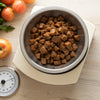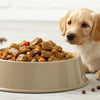How to Store Dog Wet Food: Essential Tips for Every Dog Owner
- Houndsy
Table of Contents
- Introduction
- Understanding Wet Dog Food
- Storing Unopened Wet Dog Food
- Storing Opened Wet Dog Food
- Handling Leftover Wet Dog Food
- Common Mistakes in Wet Dog Food Storage
- Benefits of Proper Storage Practices
- Conclusion
- FAQs
Introduction
Did you know that improperly stored dog food can lead to significant health risks for our furry companions? A staggering number of pet owners are unaware that wet dog food, while delicious and nutritious, can spoil quickly if not stored correctly. This makes understanding how to store dog wet food crucial not just for maintaining food quality, but for safeguarding your pet's health.
As dog parents, we all want to provide the best for our four-legged friends. Yet, how often do we consider the conditions under which we store their food? The choices we make in food storage can greatly impact our pets' nutritional intake and overall wellbeing. In this blog post, we will explore the intricacies of wet dog food storage, from proper techniques to potential pitfalls, equipping you with the knowledge to ensure each meal is just as fresh and tasty as intended.
Through this piece, we will cover various aspects, including the benefits of wet dog food, optimal storage methods, how to handle leftovers, and the importance of adhering to expiration dates. By the end of this article, we hope you will feel empowered to enhance your dog's feeding experience while simultaneously relieving the common stresses associated with food storage. So, let's dive in!
Understanding Wet Dog Food
What is Wet Dog Food?
Wet dog food, often referred to as canned or moist food, is a popular choice for many dog owners due to its flavorful appeal and high moisture content. Typically made from meat, grains, and vegetables, it often contains a higher protein content than dry kibble, making it an excellent choice for picky eaters or dogs with specific dietary needs.
But what makes wet dog food so advantageous?
- High Palatability: Most dogs find wet food irresistible due to its aroma and taste.
- Hydration: Wet food provides additional moisture, important for dogs who may not drink enough water.
- Nutritional Benefits: Many wet dog foods are formulated to meet certain health requirements, making them a great option for dogs with specific dietary needs.
Why Storing Wet Dog Food Properly is Important
Storing wet dog food correctly is essential for maintaining its freshness and nutritional value. Leftovers can quickly spoil, leading to potential health issues for our pets. Spoiled food can lead to gastrointestinal distress, including vomiting and diarrhea, which are not only uncomfortable for your dog but can lead to costly vet visits. Additionally, improperly stored food can attract pests and create unsanitary conditions in your home.
Storing Unopened Wet Dog Food
Ideal Conditions for Storage
When it comes to unopened wet dog food, proper storage is crucial for preserving its quality and ensuring your dog doesn’t consume spoiled food. Here are some recommended practices:
- Cool and Dry Environment: Store your wet dog food in a cool and dry area. Avoid places that get excessively hot, like garages or near heat sources, as temperatures above 80°F can degrade the quality of the food.
- Avoid Direct Sunlight: Keep your dog food out of direct sunlight to prevent nutrient breakdown. Keeping it in a cupboard or pantry with limited light exposure is optimal.
- Check Expiration Dates: Always pay attention to the expiration or “best by” dates on your dog food packaging. Consuming food past this date can risk your dog’s health.
Storing Opened Wet Dog Food
Immediate Recommendations after Opening
Once you open a can or pouch of wet dog food, it’s essential to manage it properly to preserve its nutritional integrity:
-
Refrigerate Promptly: After serving from a can, any leftovers should be placed in the refrigerator immediately. The ideal temperature for storage is between 40°F and 45°F. Leaving opened wet food out at room temperature increases the risk of bacterial growth.
-
Use Airtight Containers: Transfer any uneaten wet food into an airtight container to keep it fresh. If you’re using a can, consider investing in plastic can lids designed for this purpose. These can help prevent excess oxygen exposure that can spoil the food.
-
Keep it Covered: If you can’t find a lid, using cling wrap to cover the can can also do the trick, but do note it won't trap odors as effectively as a lid would.
Understanding Shelf Life Scenarios
When stored correctly in the fridge, opened wet dog food can last anywhere from 3 to 7 days, depending on the brand and specific ingredients used. Nevertheless, it's best to strive for serving it within 2 days to ensure maximum freshness.
The Danger of Temperature Fluctuations
Make it a habit to check the food in your refrigerator regularly. If the temperature fluctuates or rises above 45°F, the food could spoil faster. If you ever warm the food in order to serve it, don’t put it back in the fridge; instead, discard leftover portions.
Handling Leftover Wet Dog Food
What to Do with Leftovers
After your dog has had a meal, consider these best practices for dealing with leftovers:
-
Safe Disposal: If your dog hasn’t finished their portion in the appropriate time frame (generally about 4 hours at room temperature), it is best to throw it away. Unlike dry food, wet food can attract bacteria quickly, especially if it’s exposed to heat and moisture.
-
Clean Bowls Regularly: Regularly wash your dog’s food and water bowls with soap and hot water after each use. This prevents any residual food or bacteria from spoiling your dog's next meal.
Common Mistakes in Wet Dog Food Storage
Frequent Errors to Avoid
While storing wet dog food seems straightforward, many dog owners unknowingly make common mistakes that compromise their pet's health:
-
Failing to Refrigerate: Leaving opened cans sitting out for extended periods can lead to spoilage. Always refrigerate leftovers promptly.
-
Incorrect Container Usage: Using non-airtight containers can expose food to air and bacteria, leading to rapid spoilage. Ensuring the container is sufficiently sealed is important.
-
Not Paying Attention to Expiration Dates: It's easy to overlook the expiry dates on dog food; this can lead to a harsh surprise when serving what's presumed to be a fresh meal.
Benefits of Proper Storage Practices
Enhancing Your Dog's Feeding Experience
At Houndsy, we are committed to helping pet owners create a delightful feeding experience that's convenient and beautiful. By properly storing wet dog food, you not only reduce the risks of spoilage and health issues but also ensure that your dog enjoys the highest flavor and nutritional value.
With our Houndsy Kibble Dispenser, we put a spotlight on the convenience of feeding practices, allowing you to seamlessly manage your dog food storage while maintaining aesthetic appeal and functionality at home. Learn more about how the Kibble Dispenser can simplify your routines here.
Conclusion
Storing your dog's wet food properly is an integral part of being a responsible pet owner. Whether it's understanding the right way to manage opened cans, recognizing the signs of spoilage, or simply appreciating the joys of feeding our beloved companions, proper storage enhances both the culinary experience for our pets and the convenience for us as pet owners.
We hope this guide has provided you with critical insights into how to store dog wet food effectively. By integrating these best practices, together we can ensure every meal remains delightful and nutritious for our furry friends.
Remember, when it comes to the wellbeing of our pets, every detail matters. If you have more questions about feeding or food storage, don’t hesitate to reach out, and explore our Houndsy Kibble Dispenser to help further elevate your dog feeding experience!
FAQs
How long can opened wet dog food be left out?
Opened wet dog food should not be left out for more than 4 hours. After this time, bacteria can proliferate, making it unsafe for your dog.
Can I freeze wet dog food?
Freezing wet dog food is not recommended as it can alter the texture and taste, potentially reducing its nutritional value. Always opt to refrigerate leftovers instead.
How can I tell if wet dog food has spoiled?
Signs of spoiled wet dog food can include a sour smell, a change in color, mold growth, or a slimy texture. If your dog displays disinterest in the food or appears unwell after eating, it's best to discard the food and consult your veterinarian.
What is the optimal temperature for storing wet dog food?
Wet dog food should be stored at temperatures between 40°F and 45°F once opened. Unopened food can be stored in a cool, dry place away from heat and direct sunlight.
How can I extend the shelf life of opened wet dog food?
To maximize the shelf life of opened wet dog food, refrigerate leftovers promptly, use airtight containers, and monitor the expiration date on the packaging.












